
Pico Boom
Pocket projectors are poised to explode, but will lasers or LEDs be the pre-eminent light source?
Tiny projectors, known as pico or pocket projectors, are on the cusp of becoming the next big thing as they shrink to sizes practical for embedding into ever-smaller cell phones and other mobile devices as well as head-up displays for the military and auto industries. As these projectors continue to shrink, a battle is growing between LEDs and lasers to become the pre-eminent pico light source.
The lamps first used as light sources for tabletop projectors or rear-projection televisions are large and power hungry, and they generate enormous amounts of heat, so manufacturers have turned increasingly to LEDs and, more recently, to lasers as better choices.
Pico projectors are driven by three major technologies: digital light processing (DLP), liquid crystal on silicon (LCoS) and laser beam steering (LBS).
Texas Instruments (TI) of Dallas pioneered the DLP projection system in 1987. DLP technology is driven by a small chip containing up to 2 million hinge-mounted micromirrors. The chip switches each mirror on and off several thousand times per second, generating light or dark pixels.
“DLP can work with lasers or LEDs and is poised to take advantage of either LED or laser technology,” said Frank J. Moizio, DLP emerging markets manager at TI. “DLP products today ship with lasers.”
One such product is the 65-in. laser TV, LaserVue, from Mitsubishi Electric of Tokyo, which appeared on the market in October 2008 for $7000. Mitsubishi said the lasers give the TV about twice the color range of other high-definition TVs, while consuming as much as 75 percent less power than LCD and plasma panels.
LCoS uses liquid crystal instead of mirrors to control the amount of light each pixel receives. Its light source has shifted in recent years from high-intensity lamps to LEDs, but lasers also can be used.
LBS systems use optics to combine RGB (red, green, blue) laser beams and then guide them with a mirror to create an image.
Show me the market
With the worldwide economy in a slump, diode makers are looking to sell their product however they can. The worldwide mobile phone market, with one billion units sold last year, is an attractive one: Even a 2 percent slice translates to sales of 20 million to 30 million diodes.
Pico projector prototypes with a resolution similar to a DVD were featured at the Consumer Electronics Show in Las Vegas in 2008 and 2009 and have been trickling onto the market.
The MPro110 from 3M of St. Paul, Minn., has an LED light source and LCoS imager. The Pico, a handheld projector made by Optoma Technology of Milpitas, Calif., and featuring TI’s DLP, began shipping at the end of 2008.
Samsung Electronics Co. Ltd. of Seoul, South Korea, unveiled its Show, the first smart phone to include a pico projector, at the Consumer Electronics Show in January. Show also features TI’s DLP and is currently available only in South Korea.
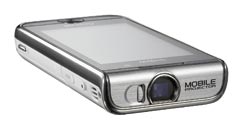
The Show, the first smart phone to include a pico projector, currently is sold only in South Korea. Courtesy of Samsung Electronics Co. Ltd.
According to industry analyst iSuppli Corp. of El Segundo, Calif., the market for pico projectors will explode by nearly 6000 percent over the next four years, growing from fewer than 50,000 units this year to more than three million in 2013.
Sanju Khatri, principal analyst for signage/projection at iSuppli, said tiny displays have been a major obstacle, preventing smart phones and small laptops from becoming primary platforms for computing and Internet access.
“The growth potential for embedded pico projectors will be limited during the next few years due to challenges in areas including power consumption, size and manufacturing,” she said. “As these issues are resolved, pico projectors will appear in many more mobile electronics devices.”
That might make microprojectors the hot accessory, possibly as soon as this Christmas. The upside: You could soon project bigger versions of the photos or videos from mobile devices onto virtually any surface without having to download them first. The downside: There may be no escaping a slide show of Uncle Phil’s two weeks in Branson, Mo.
Self-contained pico projectors now are about the size of a garage-door opener, but the trend is to embed them into portable things, such as a cell phone, an MP3 player or a digital camera.
Pico projectors with laser light sources are expected on the market sometime this year as consumers demand smaller devices. Diode manufacturers have been busy building diodes that lase at shorter and shorter wavelengths because the shorter the wavelength, the less power they use and the brighter the image is to the human eye.
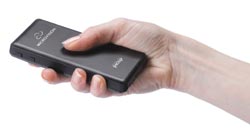
Shown is Microvision’s pico projector, the SHOWWX. Courtesy of Microvision Inc.
“We are still planning to begin initial shipments of SHOWWX later this summer,” said Matt Nichols, director of communications for the Redmond, Wash.-based Microvision. SHOWWX is a handheld pico projector driven by the laser-based PicoP display engine. (For more information on projection technology, see “Microdisplays: Coming Soon to an Eye Near You?” September 2008, p. 68, and, in this issue, “Flat Screens Go Deep – and More,” p. 56.)
Seeing red
High-power red laser diodes emitting at 660 nm are standard in devices such as recordable DVD players, but that wavelength appears relatively dark to the human eye, making the diodes ill-suited for compact projectors equipped with RGB lasers.
Mitsubishi Electric said it solved that problem with its new red series – diodes that emit at 638 nm – which provide the brightness needed for pico projectors.
The company introduced the red diodes at Laser World of Photonics in Munich in June, saying they appear much brighter than 660 nm or even the commonly used 645-nm diodes at the same output power.
Blue (450 to 480 nm) diodes showed up about 15 years ago and are used now in Blu-ray disc players. In January at Photonics West 2009, Osram Opto Semiconductors GmbH of Regensburg, Germany, announced a blue laser with a wavelength of 450 nm and an output of 50 mW that it said is the smallest in its class.
It ain’t easy beamin’ green
One hurdle that laser makers have had to overcome is with the green wavelength, which stretches from 520 to 570 nm, with 532 considered optimal for displays.
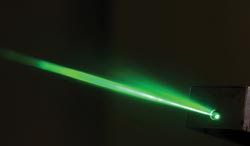
A green laser emits from an oscillator. Courtesy of Sumitomo Electric Industries Ltd.
Green lasers have been achieved through frequency conversion of infrared lasers but have been unable to directly emit green light. Recently, engineers have been inching closer to pure green emitters by producing wavelengths in the blue-green spectrum.
In February, researchers at Rohm Co. Ltd. in Kyoto, Japan, said they had pushed a gallium nitride (GaN) diode to the longest recorded wavelength yet produced, 499.8 nm, but said their technique is not suitable for mass production. Later that month, Osram Opto Semiconductors Inc., whose North American headquarters is in Sunnyvale, Calif., published a paper in Applied Physics Letters describing an electrically pumped 500-nm-emitting diode based on its blue technology. In May, in an Applied Physics Express paper, Nichia Corp. of Tokushima, Japan, said it had created a 515-nm device. (At press time, Osram Opto announced it achieved a direct-emitting green indium GaN laser at 515 nm.)
Then in July, Sumitomo Electric Industries Ltd. of Osaka, Japan, announced that it had created the first direct-emitting green laser at 531 nm. The company said it overcame a problem with GaN semiconductors (used commercially for blue LEDs), in which the material’s luminance efficiency rapidly declines as the wavelength increases, by developing a GaN crystal that inhibits the efficiency drop. The result was room-temperature pulse operation of a laser diode emitting in the pure-green region at 531 nm. Sumitomo has applied for 60 patents on the technology.
Spectralus Corp. of Santa Clara, Calif., is reporting this month at the Eurodisplay 2009 conference on its developments in green laser efficiency. In June, it announced a milestone in shrinking green lasers: an eight-pin butterfly package for its 100-mW green laser. It also said that the lasers demonstrated 30 percent optical-to-optical (808- into 532-nm wavelength) conversion efficiency levels.
The company said in a statement that it is preparing a mass-production package tailored for pico and embedded projectors for the fourth quarter of 2009.
Microvision signed a supply deal with Corning Inc. of Rochester, N.Y., in May for its G-1000 synthetic green lasers and an agreement with Osram Opto for its blue and green lasers, to ensure an ample supply of diodes as it prepares to begin commercial production of the SHOWWX.
Nichols said he expects quantities to be in the thousands for the remainder of this year, constrained more by supply than by demand, with production ramping up to more than 100,000 next year.
Lasers vs. LEDs
Laser diode makers say using lasers means that the projected images will be focus-free, will deliver a wide range of bright, vibrant colors, and will consume less power, while downplaying their major disadvantages, speckle noise – black dots that make the image appear grainy – and cost.
LED manufacturers have been making inroads into increasing the power, brightness (HB-LEDs) and efficiency of their products, which are long-lived and less expensive than lasers. They have been criticized for a lack of brightness under normal lighting conditions and for having limited focus.
Moizio said the first pico prototype DLP shown in 2007 used a pico DLP chip and three lasers. “Feedback from customers and the market were that lasers were too expensive and had associated speckle and safety issues. It was the choice of brands and manufacturers to use LEDs instead of lasers, due to their maturity, safety and cost.”
If lasers can exceed LEDs in terms of cost, performance and safety, he added, “DLP customers and manufacturers would likely take advantage of this and use lasers.”
Alexander Mönchmeier, senior product marketing engineer of opto components for Mitsubishi Electric, said that, over the next three to five years, laser diode makers will work to overcome problems such as thermal expansion and price to integrate RGB onto one submount. Red lasers are very inexpensive, about $10 to $15 apiece, because they are made in high quantities – about 15 million a month – for the DVD market. But blue lasers are expensive, as high as $1000 for one.
He said that having an RGB engine-driven pico projector could add about 15 percent to the cost of an already expensive multimedia phone.
“Demand from the consumer may be there, but what price are they willing to pay?” Mönchmeier asked.
The next big thing for little things
Nikon Corp. of Tokyo is expected to ship its first camera equipped with a pico projector, the Coolpix S1000PJ, this month. Featuring an organic LED screen, it is being touted as one of the first combination digital cameras and LCoS pico projectors and is expected to retail for about $430.
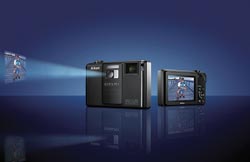
Nikon’s Coolpix S1000PJ, hitting the market this month, is the first camera equipped with a pico projector. Courtesy of Nikon Corp.
Light Blue Optics (LBO), a startup in Cambridge, UK, recently secured another $15 million in funding for its holographic laser projection technology. With its system, a diffraction pattern of the desired 2-D image is calculated using patented holographic algorithms, then shown on an LCoS microdisplay. When illuminated by coherent laser light, the desired 2-D image is projected. Three techniques, two proprietary, are used to remove speckle and improve the image.
LBO’s “cool” factor lies in its ability to turn the projected image into a touch screen via an infrared beam – invisible to the eye, superimposed over the projected image – and a sensor that detects when and where the image is touched.

Light Blue Optics’ laser technology turns the projected image into a touch screen. Courtesy of Light Blue Optics Ltd.
LBO announced in June that its first product will be released to OEM customers in the fourth quarter of 2009.
The www.brighter.eu/ (World Wide Welfare: High Brightness Semiconductor Lasers for Generic Use) Project aims to push the limits of current laser diode technology toward high brightness for health care, telecommunications and displays such as mobile projectors, head-up displays and rear-projection TVs. The €16.2 million program, a consortium of 23 companies and research institutions, began in 2006 with €9.7 million in European Union funding. It is scheduled to end in January 2010.
Over the course of the project, Brighter announced a series of firsts in lab-based records for red, infrared and green lasers. In the coming months, the red and green laser modules will be tested for display application feasibility. The goal is to create devices featuring the technology over the next two to five years.
Late last year TI began selling a DLP Pico projector development kit, called DLP Discovery, that allows developers to incorporate DLP into emerging applications.
“The open source community is using the Pico kit in a variety of interesting ways: for example, 3-D optical measurement systems and augmented reality overlay of information,” said Arun Chhabra, business development manager of DLP Embedded at TI. Based on feedback from developers, he said, “We plan to introduce kits that are targeted at more specific application areas” to accelerate experimentation-to-development time.
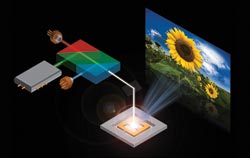
This diagram shows the internal components that make up Microvision’s PicoP engine, including laser diodes and a microelectromechanical systems chip. Courtesy of Microvision Inc.
“Stay tuned over the next six months for exciting developments on this front,” he added.
Microvision also is working with OEMs to design products that embed its PicoP, which is about the size of an Andes chocolate mint. Those products might be introduced in 2010 or 2011, Nichols said.
Published: September 2009